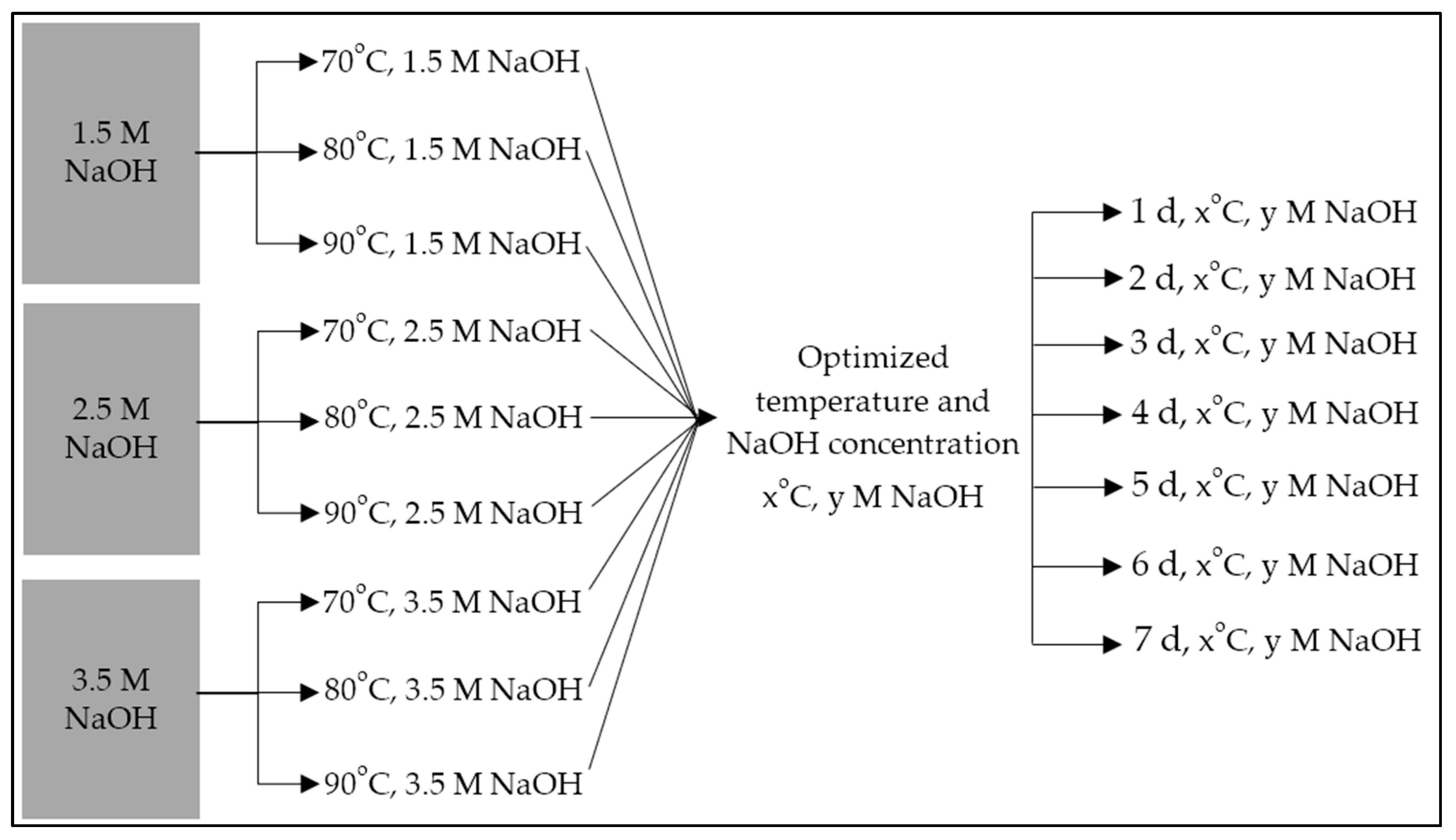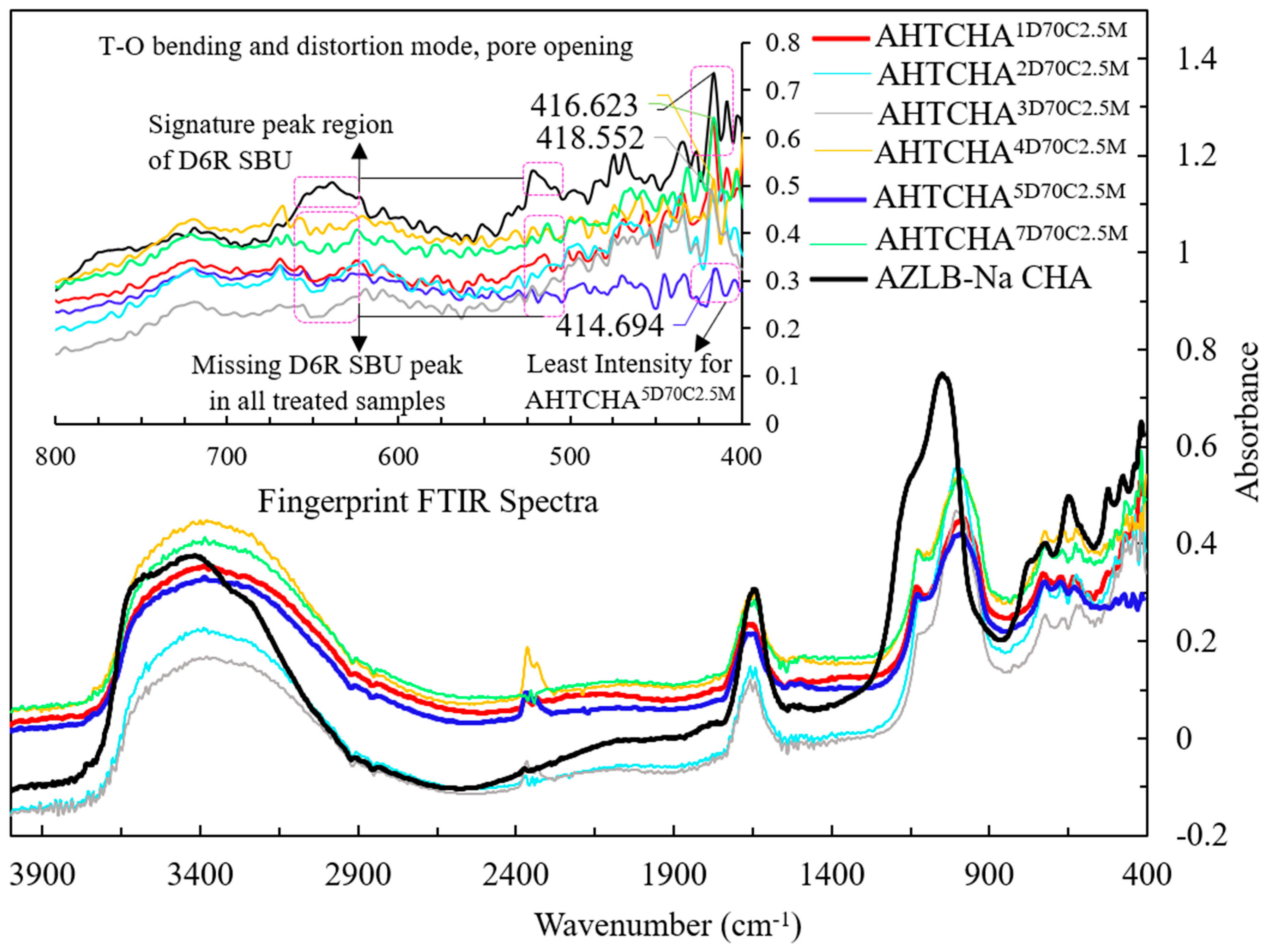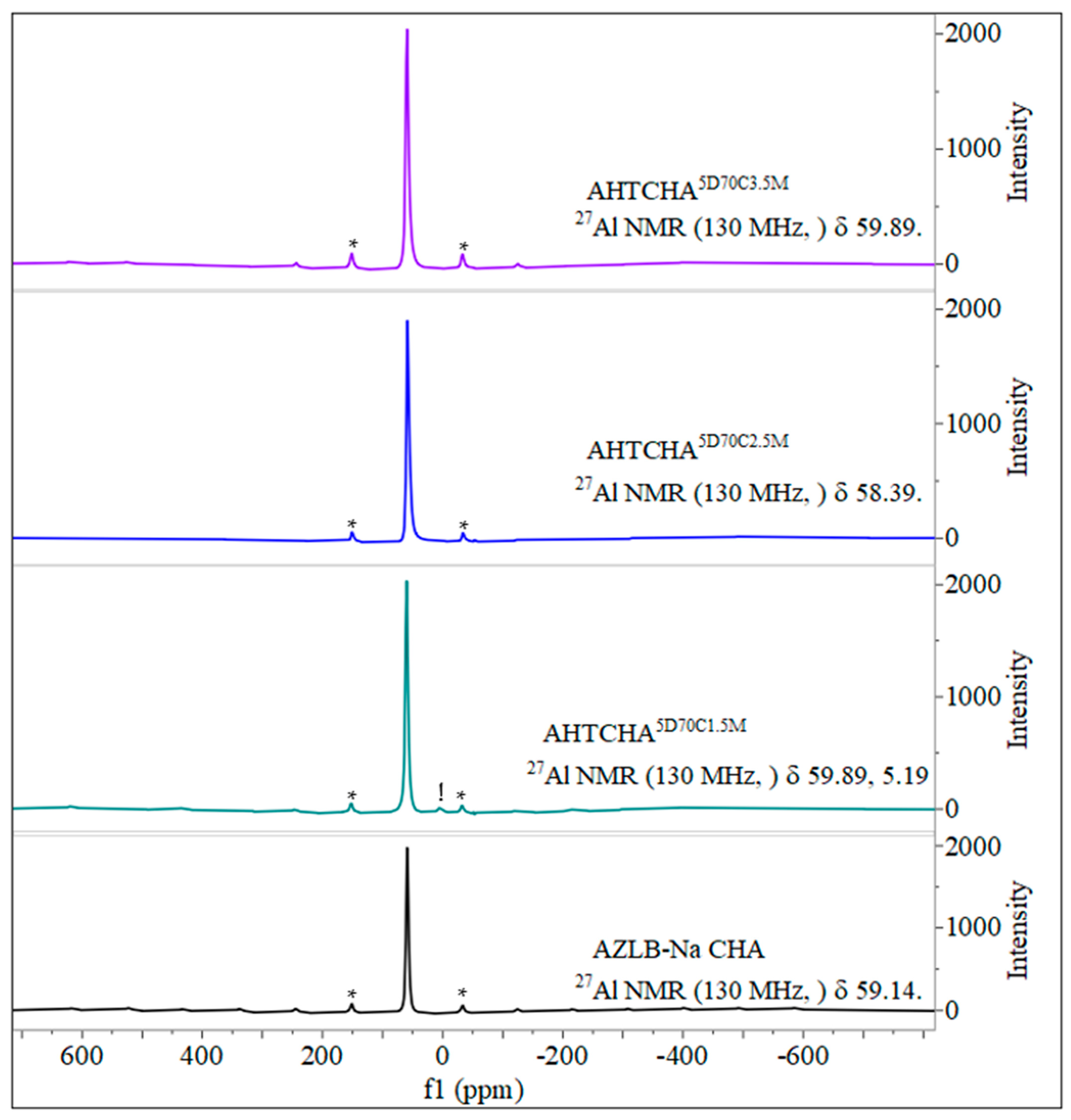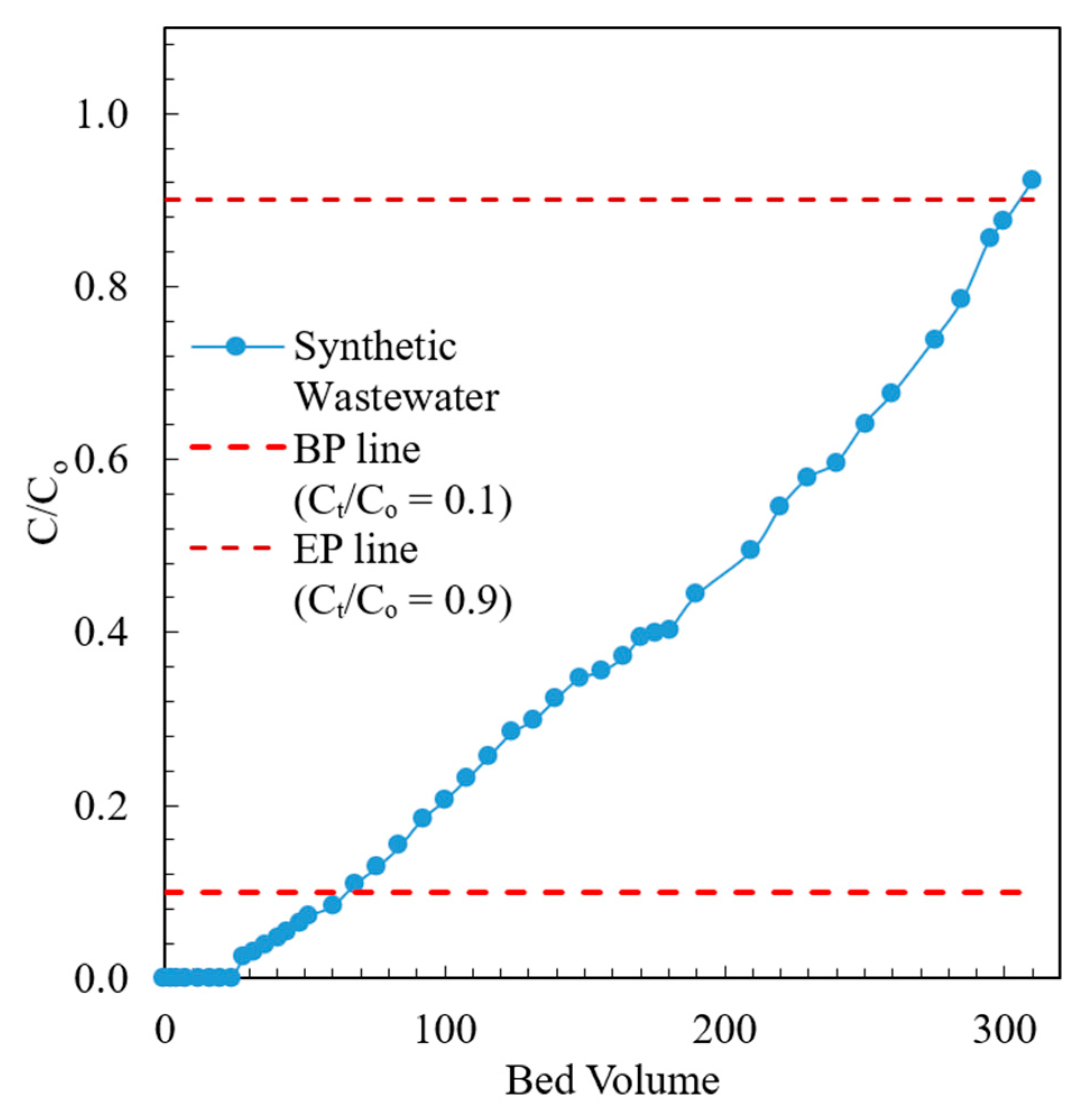Alkaline Hydrothermal Treatment of Chabazite to Enhance Its Ammonium Removal and Recovery Capabilities through Recrystallization
Abstract
:1. Introduction
2. Materials and Methods
- Twenty-five g of washed, cleaned, and dried AZLB-Na CHA in each of three 1 L solutions of 1.5 M NaOH; treated at 70 °C, 80 °C and 90 °C, respectively, for 24 h period;
- Twenty-five g of washed, cleaned, and dried AZLB-Na CHA in each of three 1 L solutions of 2.5 M NaOH; treated at 70 °C, 80 °C and 90 °C, respectively, for 24 h period;
- Twenty-five g of washed, cleaned, and dried AZLB-Na CHA in each of three 1 L solutions of 3.5 M NaOH; treated at 70 °C, 80 °C and 90 °C, respectively, for 24 h period.
3. Results and Discussion
Ion-Exchange Isotherm
- = equilibrium uptake (meq/g)
- = maximum uptake (meq/g)
- = Modified Langmuir Equilibrium constant (dimensionless)
- = equilibrium concentration (meq/L)
- = solution concentration when the solution is saturated (meq/L)
4. Conclusions
Author Contributions
Funding
Data Availability Statement
Acknowledgments
Conflicts of Interest
References
- SenGupta, A.K. Ion Exchange in Environmental Processes; John Wiley & Sons: Hoboken, NJ, USA, 2017. [Google Scholar]
- Kuznicki, S.M.; McCaffrey, W.C.; Bian, J.; Wangen, E.; Koenig, A.; Lin, C.C.H. Natural zeolite bitumen cracking and upgrading. Microporous Mesoporous Mater. 2007, 105, 268–272. [Google Scholar] [CrossRef]
- Junaid, A.S.M.; Yin, H.; Koenig, A.; Swenson, P.; Chowdhury, J.; Burland, G.; McCaffrey, W.C.; Kuznicki, S.M. Natural zeolite catalyzed cracking-assisted light hydrocarbon extraction of bitumen from Athabasca oilsands. Appl. Catal. A Gen. 2009, 354, 44–49. [Google Scholar] [CrossRef]
- Shang, J.; Hanif, A.; Li, G.; Xiao, G.; Liu, J.Z.; Xiao, P.; Webley, P.A. Separation of CO2 and CH4 by Pressure Swing Adsorption Using a Molecular Trapdoor Chabazite Adsorbent for Natural Gas Purification. Ind. Eng. Chem. Res. 2020, 59, 7857–7865. [Google Scholar] [CrossRef]
- Shang, J.; Li, G.; Singh, R.; Gu, Q.; Nairn, K.M.; Bastow, T.J.; Medhekar, N.; Doherty, C.M.; Hill, A.J.; Liu, J.Z.; et al. Discriminative separation of gases by a “molecular trapdoor” mechanism in chabazite zeolites. J. Am. Chem. Soc. 2012, 134, 19246–19253. [Google Scholar] [CrossRef] [PubMed]
- Ibrahim, K.M.; NasserEd-Deen, T.; Khoury, H. Use of natural chabazite-phillipsite tuff in wastewater treatment from electroplating factories in Jordan. Environ. Geol. 2002, 41, 547–551. [Google Scholar] [CrossRef]
- Aysan, H.; Edebali, S.; Ozdemir, C.; Celik Karakaya, M.; Karakaya, N. Use of chabazite, a naturally abundant zeolite, for the investigation of the adsorption kinetics and mechanism of methylene blue dye. Microporous Mesoporous Mater. 2016, 235, 78–86. [Google Scholar] [CrossRef]
- Kesraoui-Ouki, S.; Cheeseman, C.; Perry, R. Effects of Conditioning and Treatment of Chabazite and Clinoptilolite Prior to Lead and Cadmium Removal. Environ. Sci. Technol. 1993, 27, 1108–1116. [Google Scholar] [CrossRef]
- Lahav, O.; Green, M. Ammonium removal using ion exchange and biological regeneration. Water Res. 1998, 32, 2019–2028. [Google Scholar] [CrossRef]
- Lahav, O.; Schwartz, Y.; Nativ, P.; Gendel, Y. Sustainable removal of ammonia from anaerobic-lagoon swine waste effluents using an electrochemically-regenerated ion exchange process. Chem. Eng. J. 2013, 218, 214–222. [Google Scholar] [CrossRef]
- Langwaldt, J. Ammonium Removal from Water by Eight Natural Zeolites: A Comparative Study. Sep. Sci. Technol. 2008, 43, 2166–2182. [Google Scholar] [CrossRef]
- Montégut, G.; Michelin, L.; Brendlé, J.; Lebeau, B.; Patarin, J. Ammonium and potassium removal from swine liquid manure using clinoptilolite, chabazite and faujasite zeolites. J. Environ. Manag. 2016, 167, 147–155. [Google Scholar] [CrossRef] [PubMed]
- Cundy, C.S. Synthesis of zeolites and zeotypes. In Zeolites and Ordered Mesoporous Materials: Progress and Prospects; Elsevier: Amsterdam, The Netherlands, 2005; pp. 65–90. ISBN 0854046356. [Google Scholar]
- Li, D.; Chen, Y.; Hu, J.; Deng, B.; Cheng, X.; Zhang, Y. Synthesis of Hierarchical Chabazite Zeolite via Interzeolite Transformation of Coke-containing Spent MFI. Appl. Catal. B Environ. 2020, 270, 118881. [Google Scholar] [CrossRef]
- Zeng, Y.; Woo, H.; Lee, G.; Park, J. Removal of chromate from water using surfactant modified Pohang clinoptilolite and Haruna chabazite. Desalination 2010, 257, 102–109. [Google Scholar] [CrossRef]
- Ojha, K.; Pradhan, N.C.; Samanta, A.N. Zeolite from fly ash: Synthesis and characterization. Bull. Mater. Sci. 2004, 27, 555–564. [Google Scholar] [CrossRef]
- Szerement, J.; Szatanik-Kloc, A.; Jarosz, R.; Bajda, T.; Mierzwa-Hersztek, M. Contemporary applications of natural and synthetic zeolites from fly ash in agriculture and environmental protection. J. Clean. Prod. 2021, 311, 127461. [Google Scholar] [CrossRef]
- Pereira, P.M.; Ferreira, B.F.; Oliveira, N.P.; Nassar, E.J.; Ciuffi, K.J.; Vicente, M.A.; Trujillano, R.; Rives, V.; Gil, A.; Korili, S.; et al. Synthesis of zeolite A from metakaolin and its application in the adsorption of cationic dyes. Appl. Sci. 2018, 8, 608. [Google Scholar] [CrossRef]
- Król, M. Natural vs. Synthetic zeolites. Crystals 2020, 10, 622. [Google Scholar] [CrossRef]
- Jacobs, P.A.; Martens, J.A. Synthesis of High-Silica Aluminosilicate Zeolites; Elsevier: Amsterdam, The Netherlands, 1987. [Google Scholar]
- Derbe, T.; Temesgen, S.; Bitew, M. A Short Review on Synthesis, Characterization, and Applications of Zeolites. Adv. Mater. Sci. Eng. 2021, 2021, 1–17. [Google Scholar] [CrossRef]
- Verboekend, D.; Milina, M.; Mitchell, S.; Pe, J. Hierarchical Zeolites by Desilication: Occurrence and Catalytic Impact of Recrystallization and Restructuring. Cryst. Growth Des. 2013, 13, 5025–5035. [Google Scholar] [CrossRef]
- Valtchev, V.; Majano, G.; Mintova, S.; Perez-Ramirez, J. Tailored crystalline microporous materials by post-synthesis modification. Chem. Soc. Rev. 2013, 42, 263–290. [Google Scholar] [CrossRef]
- Moller, K.; Bein, T. Mesoporosity—A new dimension for zeolites. Chem. Soc. Rev. 2012, 42, 3689–3707. [Google Scholar] [CrossRef] [PubMed]
- Silaghi, M.C.; Chizallet, C.; Raybaud, P. Challenges on molecular aspects of dealumination and desilication of zeolites. Microporous Mesoporous Mater. 2014. [CrossRef]
- Lei, L.; Li, X.; Zhang, X. Ammonium removal from aqueous solutions using microwave-treated natural Chinese zeolite. Sep. Purif. Technol. 2008, 58, 359–366. [Google Scholar] [CrossRef]
- Leyva-ramos, R.; Monsivais-rocha, J.E.; Aragon-piña, A.; Berber-mendoza, M.S. Removal of ammonium from aqueous solution by ion exchange on natural and modified chabazite. J. Environ. Manag. 2010, 91, 2662–2668. [Google Scholar] [CrossRef] [PubMed]
- Vassileva, P.; Voikova, D. Investigation on natural and pretreated Bulgarian clinoptilolite for ammonium ions removal from aqueous solutions. J. Hazard. Mater. 2009, 170, 948–953. [Google Scholar] [CrossRef] [PubMed]
- Sengupta, S.; Pandit, A. Selective removal of phosphorus from wastewater combined with its recovery as a solid-phase fertilizer. Water Res. 2011, 45, 3318–3330. [Google Scholar] [CrossRef]
- Beaudry, J.W.; Sengupta, S. Phosphorus recovery from wastewater using pyridine-based ion-exchange resins: Role of impregnated iron oxide nanoparticles and preloaded Lewis acid (Cu2+). Water Environ. Res. 2021, 93, 774–786. [Google Scholar] [CrossRef]
- Xu, B.; Bordiga, S.; Prins, R.; van Bokhoven, J.A. Effect of framework Si/Al ratio and extra-framework aluminum on the catalytic activity of Y zeolite. Appl. Catal. A Gen. 2007, 333, 245–253. [Google Scholar] [CrossRef]
- Li, J.; Gao, M.; Yan, W.; Yu, J. Regulation of the Si/Al ratios and Al distributions of zeolites and their impact on properties. Chem. Sci. 2023, 14, 1935–1959. [Google Scholar] [CrossRef]
- Kuronen, M.; Weller, M.; Townsend, R.; Harjula, R. Ion exchange selectivity and structural changes in highly aluminous zeolites. React. Funct. Polym. 2006, 66, 1350–1361. [Google Scholar] [CrossRef]
- Ismail, A.A.; Mohamed, R.M.; Ibrahim, I.A.; Kini, G.; Koopman, B. Synthesis, optimization and characterization of zeolite A and its ion-exchange properties. Colloids Surf. A Physicochem. Eng. Asp. 2010, 366, 80–87. [Google Scholar] [CrossRef]
- Ennaert, T.; Van Aelst, J.; Dijkmans, J.; De Clercq, R.; Schutyser, W.; Dusselier, M.; Verboekend, D.; Sels, B.F. Potential and challenges of zeolite chemistry in the catalytic conversion of biomass. Chem. Soc. Rev. 2016, 45, 584–611. [Google Scholar] [CrossRef] [PubMed]
- Oumi, Y.; Nemoto, S.; Nawata, S.; Fukushima, T.; Teranishi, T.; Sano, T. Effect of the framework structure on the dealumination-realumination behavior of zeolite. Mater. Chem. Phys. 2003, 78, 551–557. [Google Scholar] [CrossRef]
- Davis, M.E.; Lobo, R.F. Zeolite and Molecular Sieve Synthesis. Chem. Mater. 1992, 11, 756–768. [Google Scholar] [CrossRef]
- Flanigen, E.M.; Khatami, H. Infrared Structural Studies of Zeolite Frameworks. In Molecular Sieve Zeolites—I; ACS Publications: Washington, DC, USA, 1977; pp. 99–123. [Google Scholar]
- Karge, H.G.; Geidel, E. Vibrational Spectroscopy. In Characterization I. Molecular Sieves—Science and Technology; Springer: Berlin, Germany, 2004; pp. 1–200. [Google Scholar]
- Byrappa, K.; Suresh Kumar, B.V. Characterization of Zeolites by Infrared Spectroscopy. Asian J. Chem. 2007, 19, 4933–4935. [Google Scholar]
- Man, A.J.M.; De Santen, R.A. Van The relation between zeolite framework structure and vibrational spectra. Zeolites 1992, 12, 269–279. [Google Scholar] [CrossRef]
- Mozgawa, W. The relation between structure and vibrational spectra of natural zeolites. J. Mol. Struct. 2001, 596, 129–137. [Google Scholar] [CrossRef]
- Pechar, F.; Rykl, D. Study of the vibrational spectra of natural natrolite. Can. Mineral. 1983, 21, 689–695. [Google Scholar]
- CHA: 3d Drawing. Available online: https://america.iza-structure.org/IZA-SC/framework_3d.php?STC=CHA (accessed on 20 November 2023).
- Database of Zeolite Structure. Available online: https://europe.iza-structure.org/IZA-SC/framework.php?STC=ANA (accessed on 20 November 2023).
- Fultz, B.; Howe, J. Diffraction Lineshapes. In Transmission Electron Microscopy and Diffractometry of Materials; Springer: Berlin/Heidelberg, Germany, 2000; pp. 423–455. ISBN 9783540738855. [Google Scholar]
- Treacy, M.M.J.; Higgins, J.B. Collection of Stimulated XRD Powder Patterns for Zeolites; Elsevier: Amsterdam, The Netherlands, 2001; Volume 4. [Google Scholar]
- Coombs, D.S. X-ray observations on wairakite and non-cubic analcime. Mineral. Mag. J. Mineral. Soc. 1955, 30, 699–708. [Google Scholar] [CrossRef]
- Baerlocher, C.; Mccusker, L.B.; Olson, D.H. Atlas of Zeolite Framework Types; Elsevier: Amsterdam, The Netherlands, 2007; ISBN 9780444530646. [Google Scholar]
- Harada, K.; Sudo, T. A consideration on the wairakite-analcime series.-Is valid a new mineral name for sodium analogue of monoclinic wairakite? Meneraological J. 1976, 8, 247–251. [Google Scholar] [CrossRef]
- Database of Zeolite Structures. Available online: http://rruff.geo.arizona.edu/AMS/viewJmol.php?id=04168 (accessed on 20 November 2023).
- American Mineralogist Crystal Structure Database. Available online: http://rruff.geo.arizona.edu/AMS/xtal_data/DIFfiles/04168.txt (accessed on 15 November 2023).
- Gatta, G.D.; Nestola, F.; Ballaran, T.B. Elastic behavior, phase transition, and pressure induced structural evolution of analcime. Am. Mineral. 2006, 91, 568–578. [Google Scholar] [CrossRef]
- Balandis, A.; Traidaraite, A. The influence of Al containing component on synthesis of analcime of various crystallographic systems. Mater. Sci. Pol. 2007, 25, 637–647. [Google Scholar]
- Stocker, M. Review on recent NMR results. In Advanced Zeolite Sciences and Applications; Elsevier: Amsterdam, The Netherlands, 1994; pp. 429–498. ISBN 9783131450715. [Google Scholar]
- Bokhoven, J.A.; Van Eerden, A.M.J.; Van Der Koningsberger, D.C. Three-Coordinate Aluminum in Zeolites Observed with In situ X-ray Absorption Near-Edge Spectroscopy at the Al K-Edge: Flexibility of Aluminum Coordinations in Zeolites. J. Am. Chem. Soc. 2003, 412, 7435–7442. [Google Scholar] [CrossRef] [PubMed]
- Omegna, A.; Bokhoven, J.A.; Van Prins, R. Flexible Aluminum Coordination in Alumino—Silicates. Structure of Zeolite H—USY and Amorphous Silica—Alumina. J. Phys. Chem. B 2003, 107, 8854–8860. [Google Scholar] [CrossRef]
- Fyfe, C.A.; Thomas, J.M.; Klinowski, J.; Gobbi, G.C. Magic-Angle-Spinning NMR (MAS-NMR) Spectroscopy and the Structure of Zeolites. Angew. Chemie Int. Ed. English 1983, 22, 259–275. [Google Scholar] [CrossRef]
- Smith, L.J.; Eckert, H.; Cheetham, A.K. Site preferences in the mixed cation zeolite, Li,Na-chabazite: A combined solid-state NMR and neutron diffraction study. J. Am. Chem. Soc. 2000, 122, 1700–1708. [Google Scholar] [CrossRef]
- Azizian, S.; Eris, S.; Wilson, L.D. Re-evaluation of the century-old Langmuir isotherm for modeling adsorption phenomena in solution. Chem. Phys. 2018, 513, 99–104. [Google Scholar] [CrossRef]
- Ayawei, N.; Ebelegi, A.N.; Wankasi, D. Modelling and Interpretation of Adsorption Isotherms. J. Chem. 2017, 2017, 3039817. [Google Scholar] [CrossRef]
- Lin, X.; Huang, Q.; Qi, G.; Shi, S.; Xiong, L.; Huang, C.; Chen, X.; Li, H.; Chen, X. Estimation of fixed-bed column parameters and mathematical modeling of breakthrough behaviors for adsorption of levulinic acid from aqueous solution using SY-01 resin. Sep. Purif. Technol. 2017, 174, 222–231. [Google Scholar] [CrossRef]
- Ma, A.; Abushaikha, A.; Allen, S.J.; McKay, G. Ion exchange homogeneous surface diffusion modelling by binary site resin for the removal of nickel ions from wastewater in fixed beds. Chem. Eng. J. 2019, 358, 1–10. [Google Scholar] [CrossRef]
- Kavand, M.; Fakoor, E.; Mahzoon, S.; Soleimani, M. An improved film–pore–surface diffusion model in the fixed-bed column adsorption for heavy metal ions: Single and multi-component systems. Process Saf. Environ. Prot. 2018, 113, 330–342. [Google Scholar] [CrossRef]










| Sample | AZLB-Na CHA | AHTCHA1D70C1.5M | AHTCHA1D70C2.5M | AHTCHA1D70C3.5M | AHTCHA1D80C1.5M | AHTCHA1D80C2.5M | AHTCHA1D80C3.5M | AHTCHA1D90C1.5M | AHTCHA1D90C2.5M | AHTCHA1D90C3.5M | |
|---|---|---|---|---|---|---|---|---|---|---|---|
| Element | |||||||||||
| O | 60.41 | 67.53 | 66.33 | 67.15 | 67.40 | 66.73 | 68.81 | 67.79 | 69.42 | 66.51 | |
| Na | 6.31 | 6.22 | 9.25 | 9.08 | 6.93 | 7.278 | 9.55 | 6.66 | 9.026 | 9.02 | |
| Si | 25.35 | 18.31 | 13.98 | 13.78 | 17.59 | 14.62 | 12.77 | 17.44 | 11.44 | 13.42 | |
| Al | 7.91 | 7.95 | 10.45 | 9.98 | 8.08 | 11.28 | 8.86 | 8.10 | 10.12 | 11.05 | |
| Si/Al | 3.2 | 2.303 | 1.34 | 1.38 | 2.18 | 1.30 | 1.44 | 2.15 | 1.13 | 1.21 | |
| Chemical | Conc. (mg/L) | Cation | Conc. (meq/L) |
|---|---|---|---|
| NaCl | 167.2 | Na+ (from NaCl and Na2HPO4) | 2.93 |
| Na2HPO4 | 10.2 | ||
| MgSO4 | 26.1 | Mg2+ | 0.53 |
| NH4Cl | 107.0 | 1.55 | |
| C12H22O11 Sucrose | 89.4 | ||
| pH | 7.4 |
Disclaimer/Publisher’s Note: The statements, opinions and data contained in all publications are solely those of the individual author(s) and contributor(s) and not of MDPI and/or the editor(s). MDPI and/or the editor(s) disclaim responsibility for any injury to people or property resulting from any ideas, methods, instructions or products referred to in the content. |
© 2023 by the authors. Licensee MDPI, Basel, Switzerland. This article is an open access article distributed under the terms and conditions of the Creative Commons Attribution (CC BY) license (https://creativecommons.org/licenses/by/4.0/).
Share and Cite
Das, D.; Sengupta, S. Alkaline Hydrothermal Treatment of Chabazite to Enhance Its Ammonium Removal and Recovery Capabilities through Recrystallization. Processes 2024, 12, 85. https://doi.org/10.3390/pr12010085
Das D, Sengupta S. Alkaline Hydrothermal Treatment of Chabazite to Enhance Its Ammonium Removal and Recovery Capabilities through Recrystallization. Processes. 2024; 12(1):85. https://doi.org/10.3390/pr12010085
Chicago/Turabian StyleDas, Dipshika, and Sukalyan Sengupta. 2024. "Alkaline Hydrothermal Treatment of Chabazite to Enhance Its Ammonium Removal and Recovery Capabilities through Recrystallization" Processes 12, no. 1: 85. https://doi.org/10.3390/pr12010085






